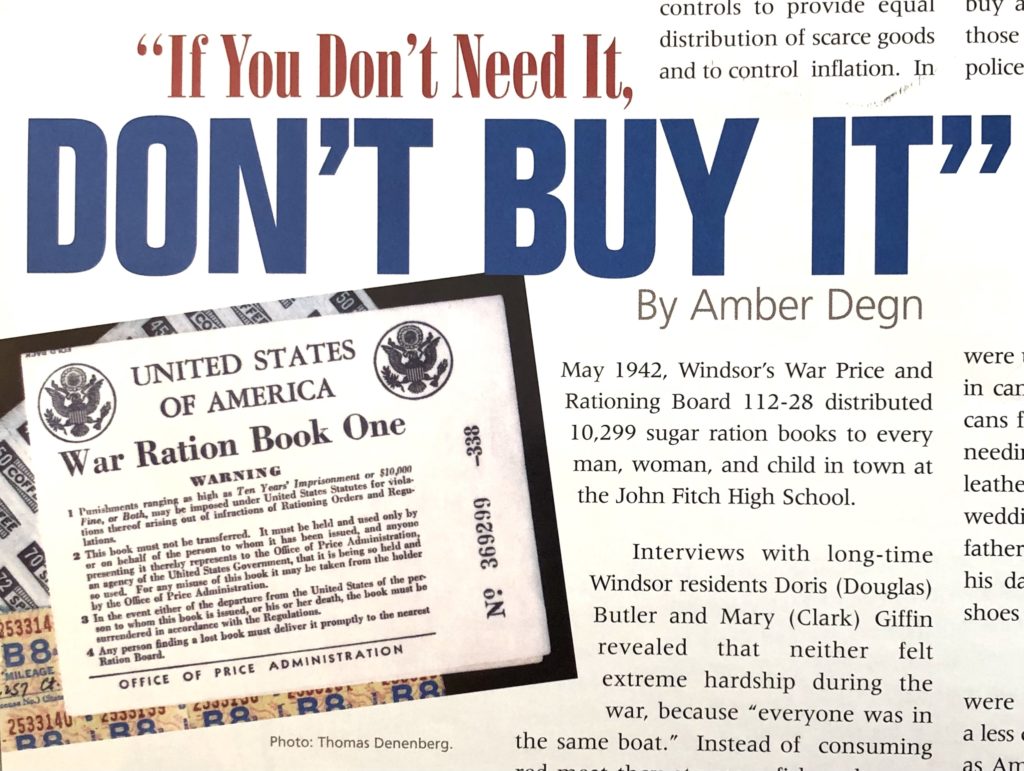(c) Connecticut Explored Inc. 2003 Nov/Dec/Jan 2004
Subscribe/Buy the Issue!
When asked recently what she remembered about rationing during World War II, one Windsor woman recalled her father, a well-respected local figure, stocking up on sugar in April 1942 when he learned it would be rationed the next month. “He hid it in an upstairs closet. We could have been fined. He loved sugar in his coffee, that was the only thing.” The stigma associated with hoarding rationed goods was both a reality and a bit of wartime propaganda. Printed on each ration book was the threat of a $10,000 fine and imprisonment for violations, declaring them “an effort to deny someone his share . . . Such action, like treason, helps the enemy.” At a time when many of Windsor ‘s boys were fighting overseas, this stigma was very powerful. Sixty years later, the woman, who was just a teenager in 1942, asked to remain anonymous so that her father’s good name would not be tarnished by his wartime sweet tooth.
Exhorted by the federal Office of Price Administration (OPA) to “Give your whole support to rationing. . . Be guided by the rule: ‘If you don’t need it, DON’T BUY IT,'” Americans restricted consumption of tires, gasoline, sugar, butter, red meat, shoes, stockings, and many other products and materials. The federal government instituted rationing and price controls to provide equal distribution of scarce goods and to control inflation. In May 1942, Windsor’s War Price and Rationing Board 112-28 distributed 10,299 sugar ration books to every man, woman, and child in town at the John Fitch High School.
Interviews with long-time Windsor residents Doris (Douglas) Butler and Mary ( Clark ) Giffin revealed that neither felt extreme hardship during the war, because “everyone was in the same boat.” Instead of consuming red meat they ate more fish and game. Butter was replaced by Oleo, a new product that came in a small bag. Both women recall kneading the bag so the little round ball filled with yellow powder would blend with and color the contents.
Everyone had a Victory garden, either in a plot in the public garden or at home. Giffin recalled that her father, tobacco grower Arthur Clark, had less success in his backyard garden than in his tobacco fields. The town of Windsor provided gardening classes for residents with brown thumbs and canning courses that taught residents how to preserve the “tomatoes, tomatoes, tomatoes” Butler remembers harvesting.
Those who commuted by car, such as Butler ‘s next door neighbor Harmon Barber, who worked at the Travelers, received a B sticker for their windshields, permitting them enough gas to get to and from work. Those who drove only for pleasure received an A sticker, and were limited to approximately three gallons per week. Truckers got T stickers, and could buy as much gas as necessary, as could those with E stickers who were usually policemen or other emergency personnel.
Rationing, as the small OPA-distributed books filled with stamps stated, was a vital part of the home front war effort. Rubber-producing countries were under Japanese control. Ships normally delivering coffee and sugar to the U.S. now were used for military purposes. Tin used in cans was required for armaments and cans for soldiers’ rations. With the army needing 15 million combat boots, shoe leather was also rationed. Butler ‘s 1945 wedding shoes were plastic and Clark ‘s father sacrificed one of his shoe stamps so his daughter could have a pair of dress shoes at college.
While rationing and recycling were necessary, victory gardens were a less critical, but important morale booster as American farms continued to produce during the conflict. These gardens provided a way for Windsor and communities across the country to play a role in the war effort and no doubt eased more than one guilty conscience fretting over a bag of sugar in the upstairs closet.
The Windsor Historical Society, located at 96 Palisado Avenue, is open Tuesday to Saturday 10 AM to 4 PM. For more information call 860-688-3813.
Amber Degn was curator of the Windsor Historical Society.
Explore!
Read more stories from the 2003 Nov/Dec/Jan 2004 issue
Read more stories about Connecticut in World War II in our special 75th anniversary issue Fall 2020
Read more stories about Connecticut at War on our TOPICS page

